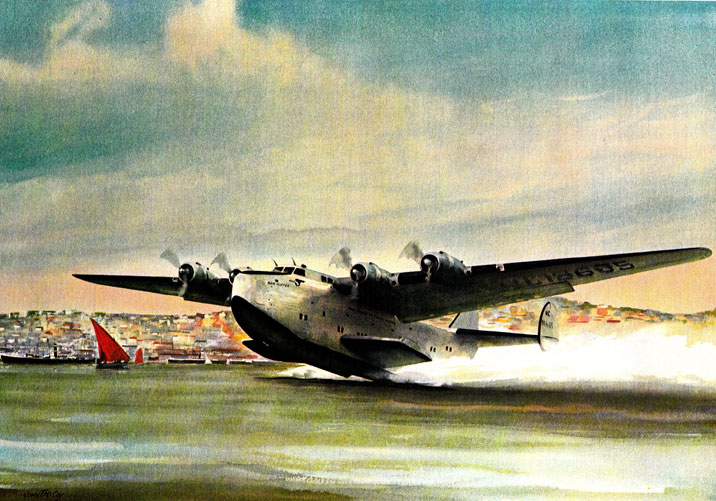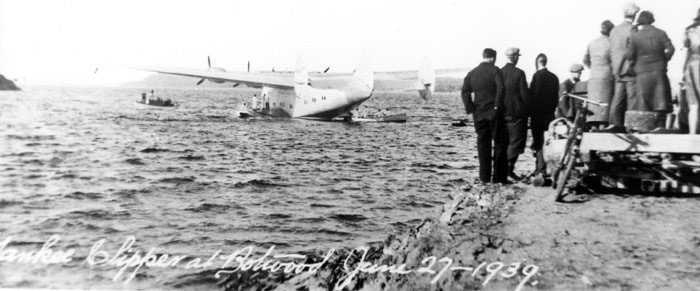

 |
 |
|
| |
||
|
Vol. 8 No. 68 WE COVER THE WORLD Sunday June 28, 2009 |
Pan Am Opens Atlantic In 1939

Weekend Special—Regular
readers may have seen our story “From My House to Bauhaus” this
past week in Air Cargo News FlyingTypers.
While preparing a different story, that trip came
to mind. One thing inevitably leads to something else.
It was cathartic to sit at a picnic table outside
the Bauhaus in Dessau, Germany with a big cup of coffee and a sandwich, despite
the absence of Walter Gropius, founder of the landmark school of art.
The signs of a life well lived, spattered with
generous contributions to the world of design, can be found in Boston, where
Herr Gropius taught at Harvard, in Lincoln, Massachusetts, the site of his now
landmark home, and at the Pan Am Building in Manhattan, which he helped design.
When looking at the Pan Am (now Met Life) Building
that straddles Park Avenue and broods over the delicate, landmark Grand Central
Station, we are reminded that not everything Gropius was a part of was entirely
stellar.
This is not to say that the Pan Am Building is
not beautiful, but plopping it down above Grand Central Station was probably
more the desire of Pan Am founder Juan Trippe, perhaps as an attempt to lord
over the railways the grand power of flight.
There is a distinct connection between Bauhaus,
Pan Am’s 1934 Dinner Key Florida flying boat base and the sister facility,
the Marine Air Terminal (MAT) and companion giant maintenance hangar that were
built at LaGuardia in 1939-40. They grab your attention like a sock in the jaw.
 |
The design of both airport terminals
is clean, functional and beautiful, minimalist and brilliant.
Those airport buildings and others are possibly
why Herr Gropius got involved with PAA Park Avenue project.
Today, it is hard to imagine how powerful Pan
Am once was and how compelling the challenge for managers and others such as
Herr Gropius to say no to Juan Trippe and anything he wanted.
These were our thoughts when it came to us that
today 70 years ago marked the first scheduled airline service across the Atlantic
Ocean by Pan American World Airways.
On June 28, 1939, a 100-ton Boeing B314 departed
from Port Washington, New York to Lisbon, Portugal.
For the record, most Clipper flying boat flights
later served Southampton, England via Foynes, Ireland.
 The
Port Washington flying boat airport was located a dozen miles from New York’s
LaGuardia Airport and was the place the Clippers would reside until 1940 when
MAT at LaGuardia Airport opened.
The
Port Washington flying boat airport was located a dozen miles from New York’s
LaGuardia Airport and was the place the Clippers would reside until 1940 when
MAT at LaGuardia Airport opened.
Test flights by both Pan American and British
Overseas Airways Corporation (BOAC) were conducted from Port Washington in 1937.
PAA utilized Sikorsky S42 flying boats that were
built in College Point, NY, just across the waters of Bowery Bay from LaGuardia
Airport.
Some facilities were created at PW, including
a coupe of small line shacks (right) that doubled as a place to stash passengers
in bad weather.
Nothing grandiose was ever considered for PW because
PAA was destined for the elegant Marine Air Terminal at LGA, that would serve
the Clippers very brief era until the end of WW11.
In point of fact, MAT was the only place anyone could go for an international
flight in or out of Gotham until 1948, when IDL (JFK) opened for business.
The first B314 to depart Port Washington was on
June 28, 1939. It was The Dixie Clipper; it had a full kitchen, sleeping quarters
and accommodations for over 70 passengers. It was posh and extravagant.
In reality, The Dixie Clipper was a flying hotel
with separate dressing rooms for men and women and a well-stocked bar.
 |
She also had a lounge that doubled
as a dining room, and a deluxe cabin in the tail section that converted to a
bridal suite.
Other elegant touches include a spiral staircase
(a feature repeated in the B377 and also, believe it or not, just recently in
the Emirates A380) and soundproof compartments.
The departure and arrival of this 109-foot flying
giant anywhere in 1939 was, to put it mildly, a major event.
Today, little is left at Port Washington of this
great story of the origins of modern commercial flight.
It only makes it sadder that the generation that
built the service is either long gone or on the way to their greater reward
as the 21st century hurdles along.
| |
In Foynes, a place that was bypassed
by the Clippers as soon as they didn’t land in the water anymore (shortly
after WWII brought along the advent of the four-engine landplanes), there is
an absolutely fantastic air museum. Under the care of a wonderful visionary
lady named Margaret O’Shaughnessy, the museum has collected a lot of items
and has even reproduced a mock up, full-sized version of a B314 Clipper –
fully outfitted!
In Port Washington there is a marker to commemorate
the historic flight of 70 years ago and nearby, a small seafood restaurant called
Louie’s.
When Margaret and her crew were starting up 20
years ago, we sat in Louie’s and drank beer and dreamed together.
Pan Am was still in business.
None of us could have ever imagined our world
without Pan Am. In 1991 when they went out of business, it was a shock to us
all.
Today, we are going out to Louie’s to have
lunch and celebrate the anniversary of that first Pan Am B314 scheduled flight
across the Atlantic Ocean. With that visit we will attempt to honor all the
great things that have happened in our world of commercial aviation as a result
of that flight.
Flowers will be tossed on the water in memory
of another time, and we will recall with thanks all of the people those pioneering
flights inspired, from Freddy Laker to Margaret O’Shaughnessy , to the
hundreds of thousands of everyday people who jump the pond with ease because
of the development of modern commercial aviation.
Geoffrey/Flossie Arend